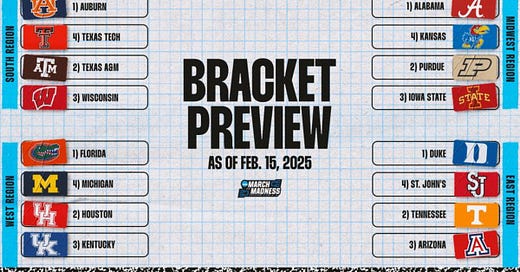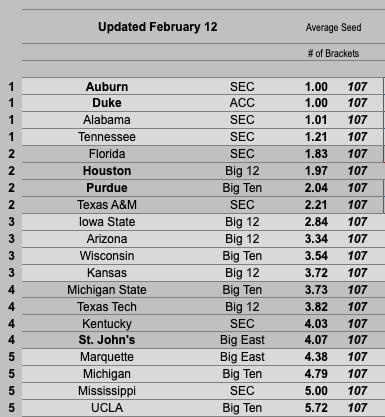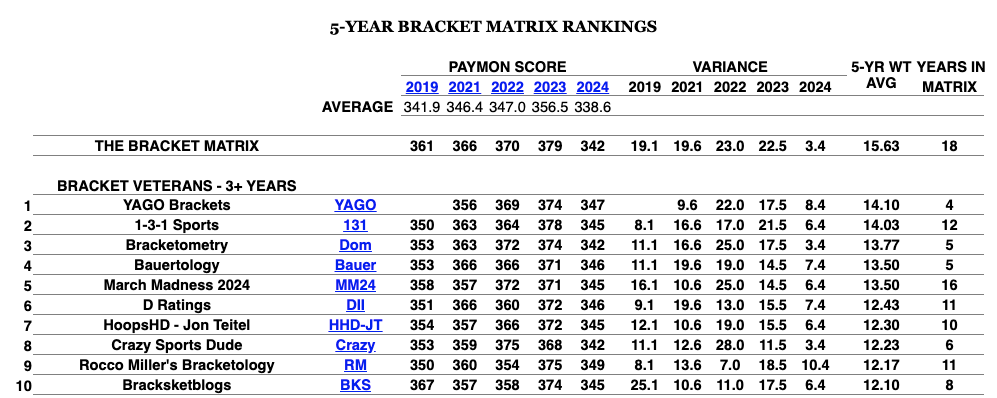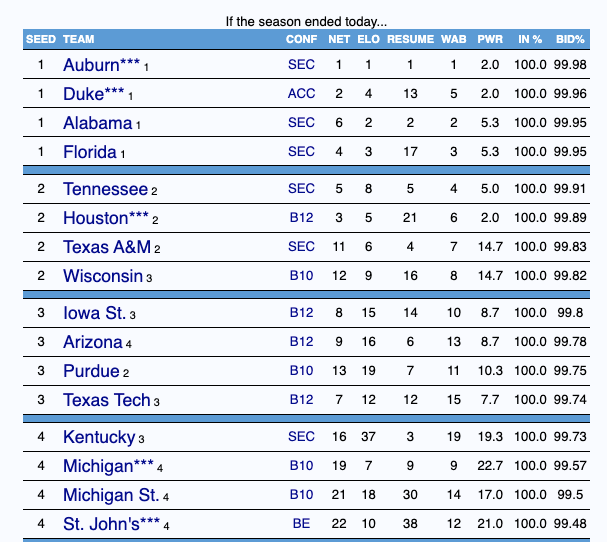This is a bit of a rant, sorry. If you want the actual Will-style analysis, I have a piece on Creighton coming Thursday. Sorry!!!
On Saturday afternoon, the Selection Committee revealed their top 16 seeds in the NCAA Tournament. They look like this.
This is informational in the sense that it’s going to rig every bracketologist’s mind into copying it going forward. “Well, the Selection Committee had it like this, so why shouldn’t I?” Friends, the Selection Committee is a group of 12 people that does this bracket preview to sate the minds of freaks like me who need to know every bit of information all of the time and can never, ever be patient.
Take a look at Bracket Matrix last Thursday, the 13th, probably the ‘pencils down’ day for most committee members who want to get home:
Some clear divides, some not-so-clear. This is a good consensus: one that takes in 107 different opinions and sorts them as such. For the most part, people are copying each other’s work anyway, but that’s fine at this point. There’s no guiding light to copy, so it’s all a guessing game.
Now, look at today’s Bracket Matrix:
Minus Kansas (who lost Saturday night) and Arizona (lost Saturday afternoon), everyone has been sorted to their rightful, committee-ordained place. Given that the 1-16 seed list is the main thing to go off of right now, I do get it. But look at some of those falloffs in one real day of action. Kansas dropped two seed lines after one (1) loss because…well, the committee told you to do so. Kentucky jumped a full seed line even AFTER losing to Texas on Saturday.
Frankly, some of it’s a little shameless. CBS’s Jerry Palm, ranked 164th out of 179 qualifying bracketologists, had Memphis as a 4 seed on Thursday. After one (1) loss and the Tigers not even being close to the 1-16 seed list, Memphis is now a 7 seed in Palm’s latest bracket. Ole Miss was a 4 in Palm’s Thursday bracket, yet after a home Quad 1 loss to Mississippi State and the note they weren’t in the committee’s top 16 seeds, they’re now a 6. Meanwhile, Palm had Arizona as a 5 seed prior to Saturday’s bracket reveal. After losing to Houston at home, they’re now his top 4 seed.
Palm’s not alone. On Thursday, 17 of a possible 107 brackets had Florida as a 1 seed. Now, about half of those hadn’t been updated to capture then-1 seed Tennessee’s road loss to Kentucky. Fine enough; of the ones that had updated post-UT loss, Florida was a 1 seed in 16 of the 30. Pretty good ratio. Now, after both teams won on Saturday in home games against Quad 2 or 3 opposition, Florida is a 1 seed in 66 of 67 brackets that have been updated after Saturday’s reveal. (Hat tip to “The Barking Crow”, the lone holdout that probably incorrectly has Florida as a 2 and Houston a 1.)
Alternately, consider the Kentucky Wildcats. On Friday, after defeating Tennessee on Tuesday, Kentucky was a 3 seed in 15 of 30 (50%) brackets, a 4 in 13 of 30, and a 5 seed in two brackets. The only meaningful result of any kind since Friday morning was Kentucky losing a road game to Texas 82-78 in which they blew a five-point lead with four minutes to play.
Now, losing on the road to Texas is not a bad loss by any stretch. This is a Quad 1 loss, and the Longhorns sit at 84% to make the Tournament, per Torvik. You can do far worse than losing on the road to a 9 seed. Yet it is a loss, and generally, when teams lose games - as Kentucky did! - their resume is downgraded however slightly. From Friday to today, UK went from 15th to 19th in Wins Above Bubble, 15th to 16th in NET, and 18th to 19th in KenPom. You’ll notice all of those are slight downgrades.
Today, at Bracket Matrix, Kentucky moved up from a consensus 4 seed and 15th overall to a consensus 3 seed and 11th. Why? Because the Selection Committee’s Saturday reveal had them a 3 seed and 10th overall. This is despite predictive models, such as Bart Torvik, Team Rankings, and Haslametrics, all moving Kentucky down a peg since last Friday. Now, despite having a new loss on their resume and not moving up in any metric since Saturday morning at 11:59 AM ET, Kentucky is a 3 seed in 51 of 71 (72%) brackets.
While I appreciate the bracket reveal as moderately useful information and a snapshot of the season to-date, it loses its usefulness with every game played that follows. Kentucky is just one piece of real consternation. Poor Michigan State beat Illinois, currently 20th! at KenPom, by 14 on the road Saturday and nearly dropped from the top 4 seed to a consensus 5 because the bracket reveal (likely) had them 17th instead of 16th.
I’ve seen several credit the bracket reveal as this significant event in the season that tells you where a team is going to be seeded in a month. That’s fine, I guess, but what about recent history says this is so? Of last year’s mid-February S-curve, exactly zero of the 16 teams listed on that Saturday ended the season in their same position. Nine of the 16 changed seed lines entirely. In 2023, exactly two teams stayed in the same position (Alabama and Houston), while seven teams changed seed lines.
This isn’t a gospel for us to hold strictly to. It’s merely a snapshot of what 12 people thought at the time of the reveal. More than that, it’s content, and God knows we cannot function as human beings without our endless stream of content. I don’t think the bracket reveal harms anyone, so I’m tempted to apply ‘Let People Enjoy Things’ logic to it, but perhaps this man’s view is right and I should be meaner.
The other problem: the Bracket Matrix has ended up being better than any actual bracket. Using a five-year rolling average, the Matrix consensus beats any analyst by a mile.
There are people I like in this field - Bauertology and Rocco Miller chief among them, because they don’t peddle BS and didn’t follow the Committee exactly - but largely, this herding to consensus is almost like basketball’s version of poll herding. I don’t believe it to be a coincidence that from 2016 (the last pre-February ‘reveal’) to now, the Matrix consensus has grown far stronger as people herd to it more and more.
One could say that this is due to the proliferation of bracketology as a practice, and to be sure, the number of 3+ year ‘veterans’ of the practice have almost doubled since 2016. Naturally, with more voices, the consensus will likely be more accurate. But when the Matrix itself is superior to any individual, do we need to listen to the individuals over the Matrix?
The other other problem is obvious: it was February 15. It is now February 18. More accurate than anything, if you’re that desperate, is to go to Bart Torvik’s site and look at his ‘if the season ended today’ page.
Or you can do the smarter thing and look at the projected numbers based on the remaining schedules, which is the only thing that matters. The bracket on Selection Sunday will not look at all like the ones we see now because there’s an entire month of basketball left. It may not even look like Torvik’s own projections. But what is more likely is what the TourneyCast page itself lays out: there are two very likely 1 seeds, a host of teams that could get them, and many, many other things up in the air.
Anyway, all of this is a little silly. This is mostly harmless, I think, and as long as you practice the right way to take bracketology - not seriously at all - then you’ll be fine. Avoid looking too deeply into hypothetical brackets that won’t exist tomorrow or ever again, remind yourself that a lot can happen in a month, and don’t overreact to the work of 12 people on a Saturday where everyone is bored out of their minds and needs a dopamine hit like they need air. It’ll help us all be better people.
Maybe.











